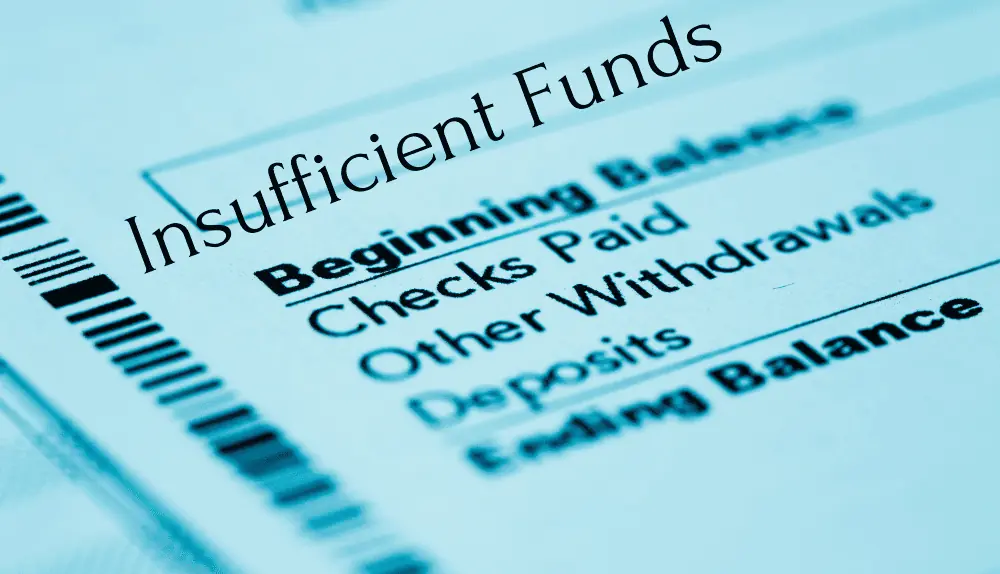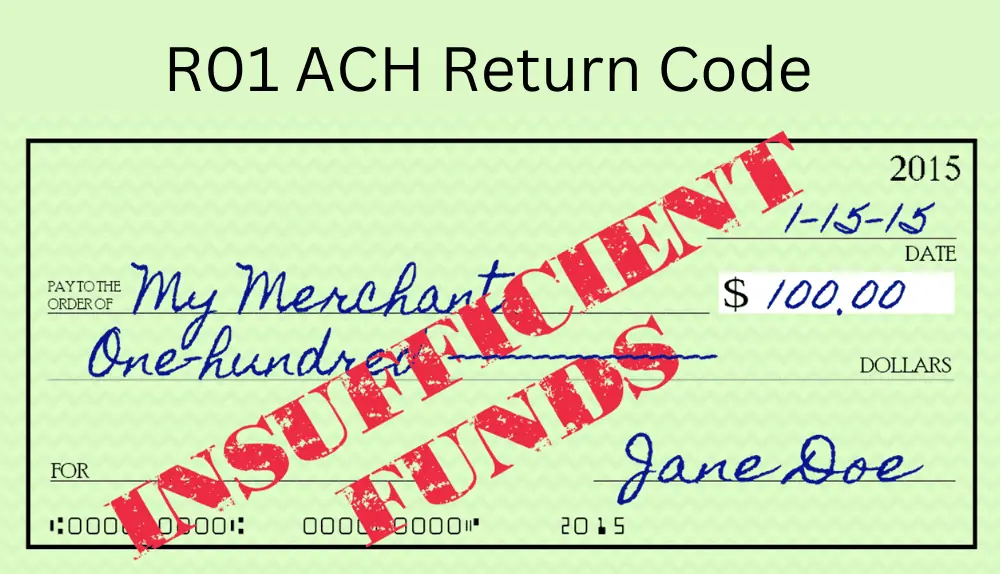Welcome to the world of banking, where every financial transaction is a delicate dance of numbers and codes. Among the myriad of codes used to keep this intricate system in check, one stands out in its significance: R01 ACH Return Code Insufficient Funds. Like a secret language, this code reveals a tale of financial insufficiency, hinting at the struggles and complexities that individuals and businesses face in maintaining their financial equilibrium.
In this captivating journey, we will dive deep into the realm of insufficient funds, unraveling the mysteries behind this enigmatic code and exploring the far-reaching implications it holds for the world of finance and beyond. So buckle up as we venture into the heart of the matter, decoding the tales of insufficiency that echo within the financial corridors!
What R01 ACH Return Code Means?
The ACH R01 Return Code is a vital piece of information within the realm of banking and financial transactions. When an ACH (Automated Clearing House) payment is initiated, it sets in motion a complex network of transfers that facilitate electronic fund transfers between banks. However, in some instances, these transactions cannot be completed due to various reasons, and the ACH R01 Return Code steps in to elucidate the primary cause.

Specifically, the ACH R01 Return Code signifies “Insufficient Funds” – a situation where the originating bank account lacks the necessary balance to cover the requested transaction. In other words, the account holder does not have enough money to fulfill the payment, resulting in the transaction’s failure. This code serves as a notification to the receiving bank that the funds are insufficient and the payment cannot be processed successfully.
For individuals and businesses alike, encountering the ACH R01 Return Code can be a frustrating experience, leading to delays, penalties, and potential damage to their financial reputation. Understanding the implications of insufficient funds is crucial in managing finances responsibly and avoiding costly mistakes. It underscores the importance of maintaining a healthy balance in bank accounts and ensuring that sufficient funds are available before initiating any transactions.
Overall, the ACH R01 Return Code’s significance lies in its ability to communicate the occurrence of insufficient funds during an ACH transaction. It serves as a reminder of the delicate financial balance that governs our everyday transactions, prompting individuals and businesses to be vigilant and well-prepared to navigate the intricate world of electronic fund transfers.
Reasons R01 ACH Return Code Can Occur
The ACH R01 Return Code, which indicates “Insufficient Funds,” can occur due to various reasons. Understanding these reasons is crucial for individuals and businesses to avoid encountering this code and its associated consequences. Some of the common causes for the ACH R01 Return Code are:

Insufficient Balance
The most straightforward reason for this code is that the originating bank account simply does not have enough funds to cover the requested transaction. If the account balance is lower than the amount being transferred, the ACH payment will fail with the R01 code.
Account Holds
Sometimes, banks place temporary holds on funds due to pending transactions, such as checks that have not yet cleared or debit card authorizations. These holds can result in insufficient funds for the ACH transaction to be successful.
Account Overdraft
If the account has an overdraft protection feature enabled, it may allow transactions to proceed even if there are insufficient funds. However, if the overdraft limit is reached, subsequent transactions, including ACH payments, will be declined.
Timing Issues
The timing of transactions can also contribute to insufficient funds. For instance, if multiple transactions are initiated simultaneously, the account balance may not be updated quickly enough to reflect the correct available funds.
Stale or Invalid Account
If the bank account linked to the ACH transaction is closed, inactive, or contains invalid account information, the payment will fail with the R01 code.
Garnishments or Freezes
In some cases, a court order, garnishment, or account freeze can lead to insufficient funds for a specific transaction.
Incorrect Transaction Amount
If the transaction amount entered for the ACH payment is higher than the available balance, it will result in an insufficient funds situation.
To avoid encountering the ACH R01 Return Code, it is essential for individuals and businesses to carefully monitor their account balances, ensure accurate transaction amounts, and have adequate funds available before initiating ACH payments. Maintaining financial prudence and staying informed about the account’s status are essential steps in preventing the complications and inconveniences associated with insufficient funds.
Solutions to Fix R01 ACH Return Code
Addressing the ACH R01 Return Code, which indicates “Insufficient Funds,” requires a combination of proactive financial management and adopting suitable strategies to prevent its occurrence. Here are some effective solutions to fix and prevent the ACH R01 Return Code
Account Monitoring and Balancing
Regularly monitoring bank account balances is essential to avoid insufficient funds situations. Individuals and businesses should keep a close eye on their account activity and maintain a buffer of funds to cover unexpected expenses or pending transactions.
Automated Account Alerts
Banks often offer account alert services, enabling customers to receive notifications via email or text message when their account balance falls below a certain threshold. Setting up these alerts can provide early warnings of potential insufficient funds issues and prompt swift action to avoid the ACH R01 Return Code.
Overdraft Protection
Consider opting for overdraft protection with your bank. This service allows transactions to go through even if the available balance is insufficient, up to a predetermined limit. However, be aware that overdraft protection may come with associated fees, so it’s essential to understand the terms and costs involved.
Synchronize Transactions
Timing plays a crucial role in avoiding insufficient funds scenarios. Coordinating the timing of deposits, withdrawals, and payments can help ensure funds are available when needed. For businesses with scheduled ACH transactions, aligning them with the expected inflows of funds can reduce the risk of encountering the R01 Return Code.
Budgeting and Cash Flow Management
Implementing a well-thought-out budget and cash flow management plan is vital for businesses. By forecasting income and expenses, businesses can better anticipate cash requirements and allocate funds accordingly to avoid falling short during ACH transactions.
Verify Account Information
Accurate and up-to-date account information is crucial for successful ACH transactions. Businesses should verify the account and routing numbers provided by customers before processing payments to prevent issues arising from invalid or outdated account details.
Communication with Customers
For businesses using ACH for recurring payments, maintaining open communication with customers is essential. Notify customers in advance about upcoming charges, giving them the opportunity to ensure sufficient funds are available.
Use ACH Payment Processing Solutions
Employing reliable and efficient ACH payment processing solutions can streamline payment workflows and help prevent errors. Many payment platforms include features that check for sufficient funds before initiating transactions, reducing the risk of encountering the ACH R01 Return Code.
Educate Employees and Customers
Businesses that handle ACH transactions should educate their employees about best practices for avoiding insufficient funds situations. Likewise, customers can benefit from educational resources on managing their accounts responsibly to minimize the risk of encountering this return code.
Overall, preventing and fixing the ACH R01 Return Code “Insufficient Funds” requires a proactive approach to financial management and a focus on maintaining adequate account balances. By adopting these solutions and strategies, individuals and businesses can minimize the occurrence of insufficient funds scenarios and ensure smoother ACH transactions while safeguarding their financial reputation.
How to Avoid ACH R01 Return Code?
Customers can take several proactive steps to avoid encountering the ACH R01 Return Code. By following these guidelines, they can maintain smoother ACH transactions and prevent potential financial inconveniences:
Monitor Account Balances
Regularly check bank account balances to ensure there are sufficient funds available before initiating any ACH transactions. This simple practice can help avoid the primary cause of the ACH R01 Return Code.
Set Account Alerts
Most banks offer account alert services, allowing customers to receive notifications via email or text message when their account balance falls below a specified threshold. Setting up these alerts can provide early warnings of potential insufficient funds issues, prompting quick action to avoid the ACH R01 Return Code.
Maintain a Buffer
It’s a good practice to maintain a buffer of funds in the account to cover unexpected expenses or pending transactions. By keeping some extra funds in the account, customers reduce the risk of falling into an insufficient funds situation.
Sync Transactions with Deposits
Coordinate the timing of deposits, withdrawals, and payments to ensure sufficient funds are available when needed. For example, if customers know they will receive a direct deposit on a specific date, they can schedule their ACH transactions accordingly.
Double-Check Account Information
Before initiating an ACH payment, verify that the account and routing numbers provided are accurate and up-to-date. Incorrect account information can lead to a failed transaction and the ACH R01 Return Code.
Communicate with Billers
If customers have recurring ACH payments, such as for utility bills or subscriptions, they can maintain open communication with the billers. Notify them in advance if there are any changes in payment schedules or if they need to delay payment due to potential insufficient funds.
Budget and Plan
Customers can create and follow a budget to manage their finances effectively. By knowing their income and expenses, they can plan ahead and allocate funds appropriately to avoid potential cash flow issues.
Final Words
In conclusion, understanding and actively addressing the ACH R01 Return Code “Insufficient Funds” is crucial for individuals and businesses alike to maintain smooth and efficient financial transactions. By adopting proactive measures such as monitoring account balances, setting up alerts, and synchronizing transactions with deposits, customers can avoid the frustration and inconvenience associated with insufficient funds scenarios.
Opting for overdraft protection, verifying account information, and communicating with billers further strengthen their financial resilience. In the dynamic world of electronic fund transfers, knowledge is power, and educating oneself about ACH transactions and responsible financial management is paramount. Armed with these insights and practical strategies, customers can confidently navigate the intricacies of ACH transactions, ensuring their financial stability and safeguarding their financial reputation in the process.
Ultimately, by taking these proactive steps, customers can steer clear of the ACH R01 Return Code and embrace a more seamless and secure banking experience.
Frequently Asked Questions (FAQs)
How can I avoid encountering the ACH R01 Return Code?
To avoid the ACH R01 Return Code, ensure you maintain a sufficient balance in your bank account, use account monitoring and alert services, and synchronize transactions with your expected income and expenses. Additionally, consider opting for overdraft protection if available and verify account information before processing ACH payments.
Are ACH transactions secure?
Yes, ACH transactions are generally considered secure. They are subject to strict regulations and security measures to protect sensitive financial information and prevent unauthorized access.
What are the typical processing times for ACH transactions?
ACH transaction processing times can vary depending on the financial institutions involved. Typically, ACH credits (e.g., direct deposits) are processed within one to two business days, while ACH debits (e.g., bill payments) may take three to five business days to complete.
Can I reverse or cancel an ACH payment?
ACH payments are not as easily reversible as credit card transactions. Once an ACH payment is initiated, it cannot be canceled or reversed immediately. However, if an error is detected, you should contact your bank or the originating company promptly to discuss the situation and explore possible remedies.
What are the benefits of using ACH for businesses?
Using ACH for business transactions offers several advantages, such as cost savings compared to paper checks, faster processing times, improved cash flow management, and increased convenience for customers and employees.

